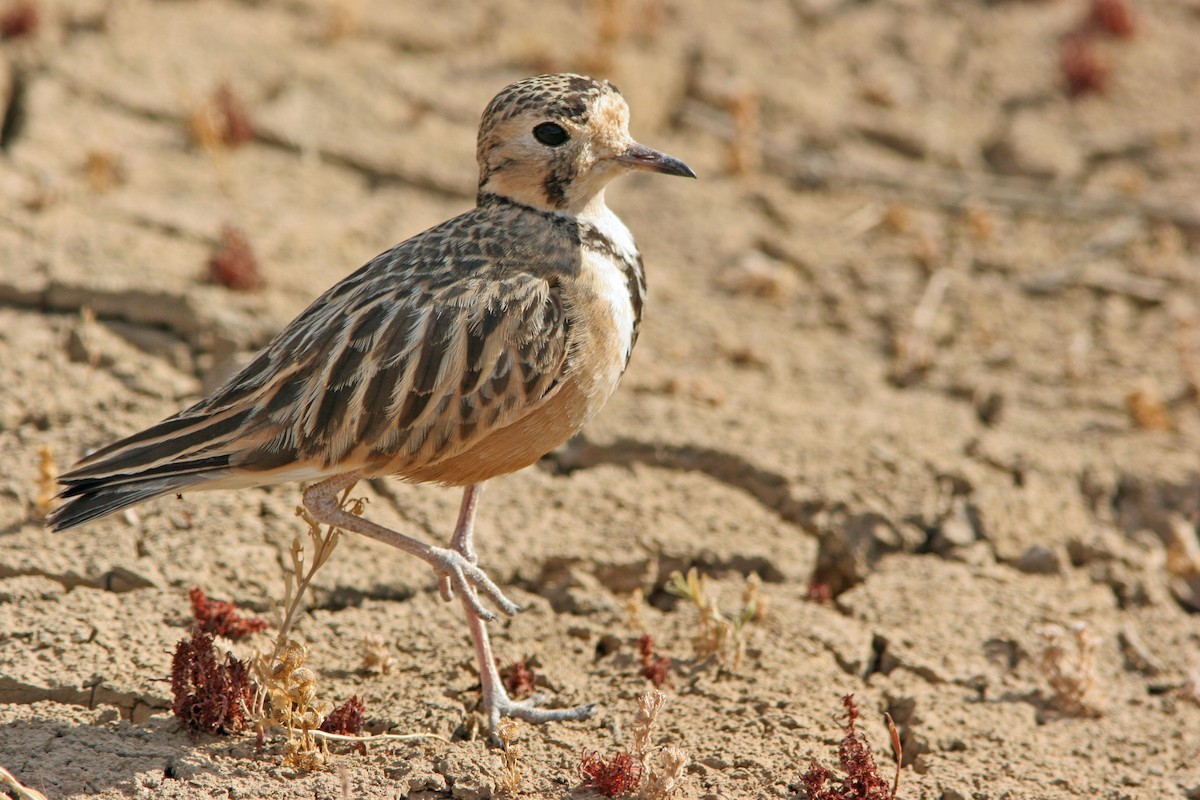Inland Dotterel
A species of Inland Dotterel Scientific name : Peltohyas australis Genus : Inland Dotterel
Inland Dotterel, A species of Inland Dotterel
Botanical name: Peltohyas australis
Genus: Inland Dotterel
Content
Description General Info
 Photo By Don Roberson
Photo By Don Roberson Description
The inland dotterel is a medium-sized plover with a distinctive cryptic plumage. Males and females are similarly sized: 19–23 cm (7.5–9 in) in length, a wingspan of 43–47 cm (17–19 in) a weight of 80–90 g (2.8–3.2 oz), and a short bill 1.7 cm (0.67 in). It is unlikely to be confused with any other species when found in its normal habitat. Its upperparts are a rich sandy buff, mottled with dark brown. The black band across the crown extending down through the eye is unique. The face, ear coverts and neck are white, as is the vent. A broad black Y shaped band extends from the hindneck down the sides of the neck across the breast to the centre of the belly. Below the band the breast, flanks and belly are sandy buff. The legs are a pale buff colour, with the feet noticeably darker. The eye is dark brown. It has a short dark bill. Males and females have similar plumage. Maclean observed that the birds moulted into a paler, less bold non-breading plumage. Immature birds lack the distinct black markings on the head, neck and breast of the adults. It calls infrequently, most often a short quiet quick or guttural kroot or krrr when taking flight. The precocial young have short dense downy feathers, pinkish-buff or cream on the upperparts with a heavy pattern of dark brown blotches. The underparts are off white. The bill and legs are pale yellow. 
Size
23 cm
Nest Placement
Ground
Feeding Habits
Inland Dotterel consumes desert shrub tips by day, using specialized salt glands for herbivory and hydration. At night, inland Dotterel becomes insectivorous, eating spiders, grasshoppers, beetles, ants, and earwigs.
Habitat
Inland Dotterel primarily inhabit open, arid landscapes with sparse vegetation, favoring saltbush and bluebush areas. Key habitat features include gibber plains, gravel flats, and clay pans with exposed ground patches. These flat and open environments may extend to coastal regions and grasslands influenced by agriculture. Seasonal movements indicate flexibility in habitat use due to climatic fluctuations.
Dite type
Carnivorous
General Info
Feeding Habits
Bird food type
Behavior
Typically in the day the birds associate in loose flocks of 10-20 birds, occasionally hundreds of birds. They are generally inactive in daytime, although they will forage on plants. At dusk the flock disperses and night sees most activity with individual birds hunting a variety of insect prey. It is during this activity that they are often encountered on outback roads. They tolerate high temperatures but will seek cover if the temperature exceeds 40 C (104 F). When approached they prefer to run away rather than fly. 
Distribution Area
The inland dotterel occurs widely in the arid south-east and south-west of Australia. Its distribution corresponds to areas below the 100mm summer rainfall isohyet. It can be found in suitable habitat within this range in all the mainland states. 
Species Status
While there are no reliable estimates, it is believed the across its range the population is relatively large and stable. The conservation classification at the IUCN is least concern. It is not listed in any Australian Federal or State acts, but is listed as vulnerable on the Victorian governments advisory list of threatened vertebrate fauna. 

 Photo By Don Roberson
Photo By Don Roberson Scientific Classification
Phylum
Chordates Class
Birds Order
Shorebirds Family
Plovers Genus
Inland Dotterel Species
Inland Dotterel